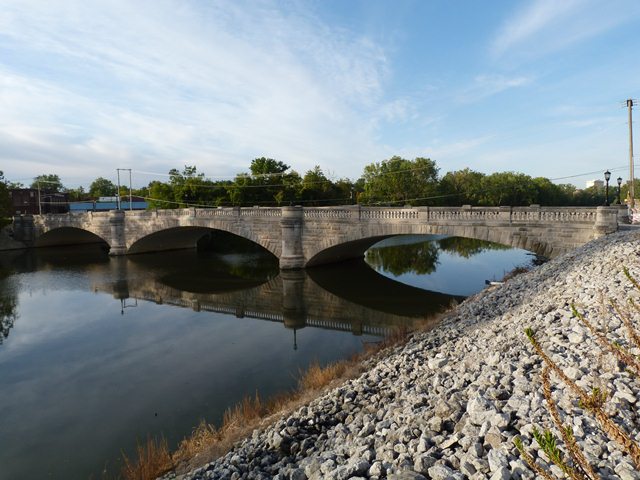We Recommend:
Bach Steel - Experts at historic truss bridge restoration.
BridgeHunter.com Phase 1 is released to the public! - Visit Now
Techumseh Street Bridge
Allen County Bridge 537, Coombs Street Bridge

Primary Photographer(s): Nathan Holth and Rick McOmber
Bridge Documented: September 21, 2012
Fort Wayne: Allen County, Indiana: United States
1912 By Builder/Contractor: Herman Tapp Construction Company of Fort Wayne, Indiana and Engineer/Design: George Jaap
2010
102.0 Feet (31.1 Meters)
310.0 Feet (94.5 Meters)
27.6 Feet (8.41 Meters)
3 Main Span(s)
200267

View Information About HSR Ratings
Bridge Documentation
View Archived National Bridge Inventory Report - Has Additional Details and Evaluation
View Historical Articles That Mention This Bridge
This bridge was designed by George Jaap, which is noteworthy because many of Fort Wayne's historic concrete arch bridges are associated with A. W. Grosvenor. It turns out even this bridge may have Grosvenor influence since when this bridge was built there was some thought that Jaap was copying Grosvenor's designs. That this bridge employs a Melan type reinforcing, which is a rare type of reinforcing but was also used by Grosvenor extensively, suggest there may be some truth to that. The extensively detailed and decorated bridge has a stone facing to enhance its aesthetic value.
In 2010, the bridge was extensively rehabilitated. Effort appears to have been made to maintain the bridge's original design and appearance.
Information and Findings From DHPA Historic Bridge SurveyStatement of Significance Despite Drayer's attack on Japp's competence, this bridge has outlived its detractor, and retains its structural and architectural integrity. Japp may have borrowed Grosvenor's structural plans, but the very considerable decoration was his own. The stone-facing of the spandrels and piers and the design of the rails are different and noteworthy. Architectural Description The Herman Tapp Construction Company of Fort Wayne won the contract to build this 321', three-span reinforced and filled concrete arch for $56,390. George Japp, who designed the structure, endured an attack upon
his competence which C.E. Drayer of Cleveland submitted to Engineering News. Drayer accused Jaap, among other things, of plagiarizing A.W. Grosvenor's plans for the Tennessee Avenue Bridge. Other Information The Allen county commissioners accepted George Jaap's plans and specifications for the Coombs Street Bridge on 24 March 1912 and then proceeded to a letting for construction. At $56,390.40, president G. Max Hofmann of the Herman Tapp Construction Company of Fort Wayne underbid Jaap by less than $100. Construction continued well into the fall of 1913. Each of the rings is segmental with Melan-system reinforcing and a rise of 12 feet and nine inches. The rings are raised vertically upon the piers and abutments. Solid spandrel walls retain the earth fill and carry the asphalt roadway between 5-foot and 10-inch sidewalks bordered by coped parapets with neoclassical balustrades. The spandrel walls and piers are faced with sandstone. George Jaap, who designed the structure, endured a public attack upon his competence by C. E. Drayer of Cleveland in the Engineering News. Drayer accused Jaap, of among other things, plagiarizing A. W. Grosvenor's plans for the Tennessee Avenue Bridge (#539). Jaap had become experienced with concrete work in part as a result of the many contracts for bridge construction and repair that he received from the Allen county authorities. Despite Drayer's attack on Jaap's competence, this bridge has outlived its detractor and retains its structural and architectural integrity. Jaap may have borrowed Grosvenor's structural plans, but the very considerable decoration was his own. The stone-facing of the spandrels and piers and the design of the rails are different and noteworthy. 100 foot center span. References Butler, Fairman & Seufert, Inc., Bridge Inspection/Reinspection Report: Allen County (Indianapolis, 1973, 1977, 1981). SIECO, Inc., Bridge Reinspection Report: Allen County (Columbus, 1993, 1995). Bridge nameplate. Allen County, "Commissioners Record," 7: 42-44, 373; 8: 138, 171, 319, 387, 404, 434-435, 439, 464, 468, 493; "Old Bridges " (Surveyors Office), 13E: 41. "Construction News," Engineering News, 14 March 1912: 143; 4 April 1912: 186. C. E. Drayer, "Concrete Bridges with Stone and Brick Facing," Engineering News, 24 June 1915: 1214-1215. R. L. Polk and Company, Fort Wayne City and Allen County Directory: 1911, 562; Fort Wayne City and Allen County Directory: 1912, 626; Fort Wayne City and Allen County Directory: 1913, 613. Two signs carved in cement: Bridge Considered Historic By Survey: Yes |
![]()
Photo Galleries and Videos: Techumseh Street Bridge
Bridge Photo-Documentation
Original / Full Size PhotosA collection of overview and detail photos. This gallery offers photos in the highest available resolution and file size in a touch-friendly popup viewer.
Alternatively, Browse Without Using Viewer
![]()
Bridge Photo-Documentation
Mobile Optimized PhotosA collection of overview and detail photos. This gallery features data-friendly, fast-loading photos in a touch-friendly popup viewer.
Alternatively, Browse Without Using Viewer
![]()
Maps and Links: Techumseh Street Bridge
Coordinates (Latitude, Longitude):
Search For Additional Bridge Listings:
Bridgehunter.com: View listed bridges within 0.5 miles (0.8 kilometers) of this bridge.
Bridgehunter.com: View listed bridges within 10 miles (16 kilometers) of this bridge.
Additional Maps:
Google Streetview (If Available)
GeoHack (Additional Links and Coordinates)
Apple Maps (Via DuckDuckGo Search)
Apple Maps (Apple devices only)
Android: Open Location In Your Map or GPS App
Flickr Gallery (Find Nearby Photos)
Wikimedia Commons (Find Nearby Photos)
Directions Via Sygic For Android
Directions Via Sygic For iOS and Android Dolphin Browser
USGS National Map (United States Only)
Historical USGS Topo Maps (United States Only)
Historic Aerials (United States Only)
CalTopo Maps (United States Only)

